Given that our earth’s threatened by adverse environmental pressures, we must transition to more energy-efficient products.
Solar-powered air conditioners take advantage of harnessing the sun’s energy to convert it to usable energy.
Let’s see how this technological advancement works and the types of solar-powered AC. Is it worth it?
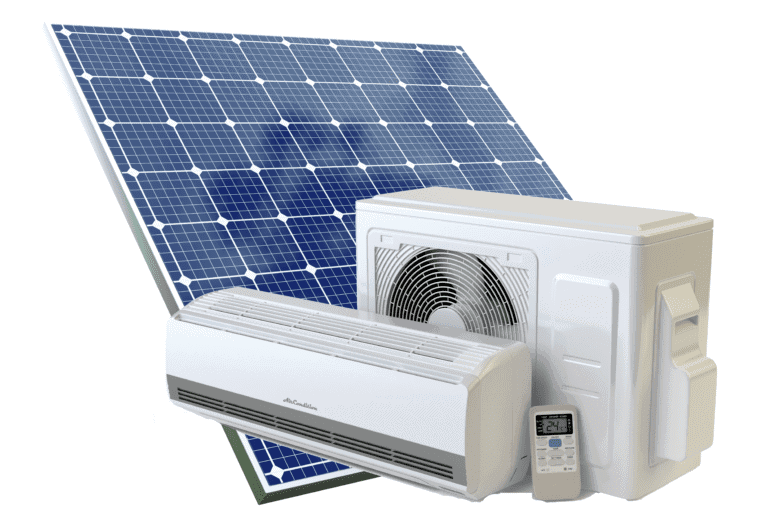
What is a Solar Powered Air Conditioner?
A solar-powered AC is also known as a solar photovoltaic (PV) air conditioner. It works the same as the typical split AC system, but the AC unit is powered with solar energy produced by solar panels instead of the energy from power grids.
The size of your system determines the number of solar panels needed to run your AC unit. However, it usually comes with two to six solar panels.
The systems are usually paired with solar batteries and inverters to steer it and store energy produced by the solar panels. The AC can use the stored energy later after sunset or on cloudy days.
What Are The Components of a Solar Powered Air Conditioner?
A solar-powered AC unit has some essential components. The system creates a functional structure that harnesses the sun’s power and uses it efficiently without losing energy.
Solar Panels
The solar panels are several photovoltaic cells connected in a single unit. These multiple PV cells work together to create higher currents, and thus more energy.
Air conditioners use a lot of energy to remove heat from your home. The solar panels appropriately installed in direct sunlight will produce the solar energy required to run your AC unit.
The solar energy from the solar panels is direct current (DC). The inverter converts the DC into an alternating current that is appropriate for usage in your air conditioner.
Solar Charge Controller
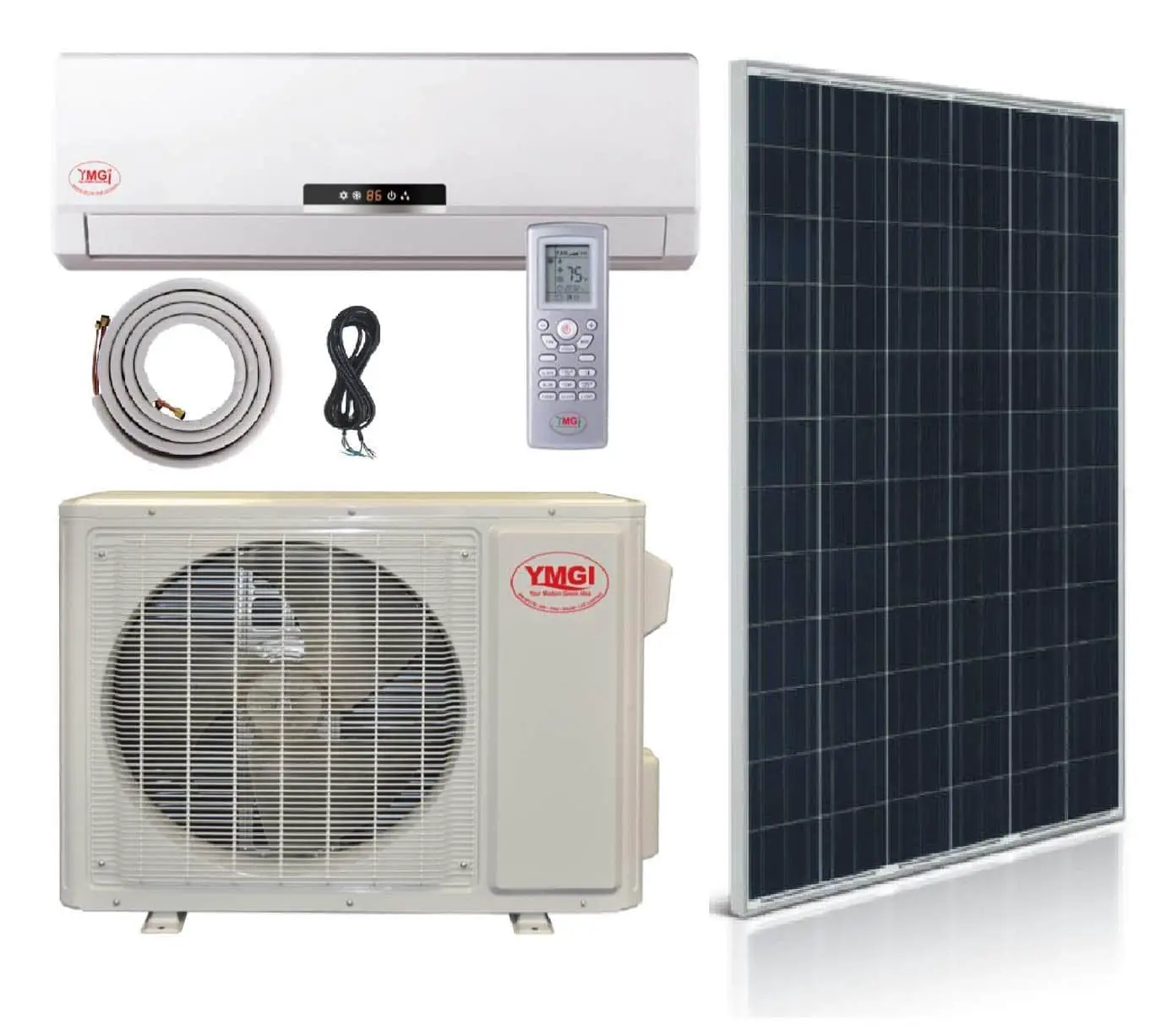
The solar charge controller, also known as the charge regulator, is a current and/or voltage regulator that prevents batteries from overcharging. It also ensures that power doesn’t run back to the solar panel during the night, preventing battery drainage.
Battery Bank
A battery bank is a group of connected batteries that uses series or parallel wiring. The battery bank grants more power storage than a single battery, and it stores electricity generated by your solar photovoltaic system. This energy can be stored to use anytime.
Air Conditioning Unit
The only AC unit you can use for a solar-powered air conditioner is an inverter air conditioning unit.
How Does a Solar Powered Air Conditioner Work?
A solar-powered AC system consists of a PV system, a charge controller, a battery bank, and an inverter air conditioning unit. We will first explain the mechanics of how a standard air conditioner and PV system operate before jumping into describing how the essential functions of the components of a solar-powered AC system work together.
This explanation will give you a better understanding of the system as a whole.
Normal AC Operations
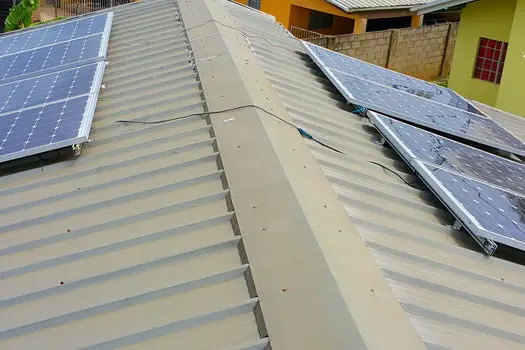
The AC Consists of Five Essential Components
- Compressor
- Refrigerant
- Expansion Device
- Evaporator
- Condenser
What Each Component Does
- Electricity operates the compressor, and the primary function is to compress the refrigerant vapor to high pressures, heating it for the refrigerant’s circulation process. It pumps refrigerant all through the system.
- The refrigerant absorbs heat into the system, circulates within the AC unit’s circuit, and is the cooling agent.
- Between the condenser and evaporator lies the expansion device. The expansion device controls the amount of liquid refrigerant that flows through into the section with low pressure in the process.
- As the refrigerant circulates, the evaporator uses the refrigerant’s liquid state to absorb heat from the cooling space into the AC system.
- The condenser removes the heat from the system that the evaporator absorbed as the refrigerant temperature lowers.
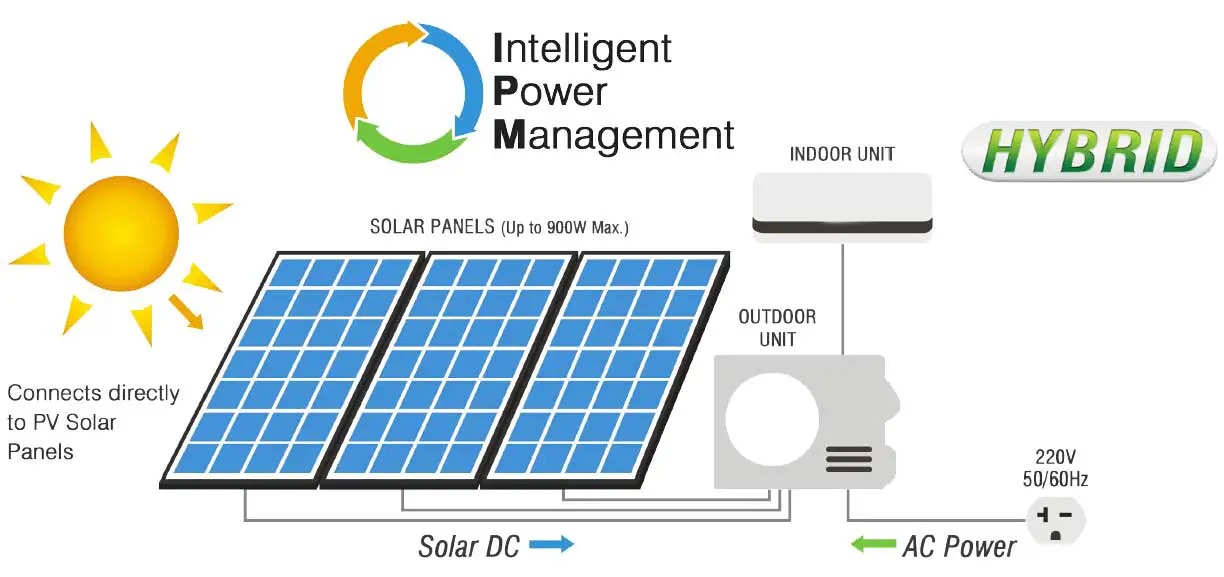
How it Flows Together
- The system starts operating when the cold refrigerant flows over the evaporator coil located in the cooling space to absorb heat.
- The cold refrigerant now comes out as low-pressure gas from the evaporator coil.
- The cool, low-pressure gas is taken to the outside unit of the AC to the compressor.
- The low-pressure becomes high-pressure gas.
- Hot gas goes over the condenser coil, and the heat is released outside.
- Some of the hot gas is blown over the condenser again, and it condenses back into the warm liquid.
- The hot liquid goes back to the evaporator, passing through the expansion device that lowers the fluid’s pressure and temperature.
- The whole process starts again and continues in a cycle.
The PV System
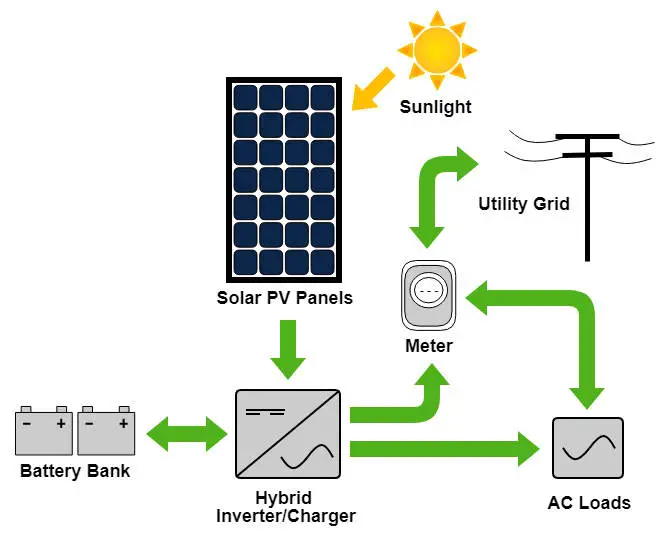
The PV system converts the energy of sunlight straight into electricity. The process is simple and involves three subsystems.
- The first subsystem is the PV modules that convert sunlight into electricity.
- The second subsystem is a set of structures and devices that apply the PV correctly to the load.
- The third subsystem is the ‘balance of system’ that includes the inverter, charge controller, and battery pack.
The PV-AC System Operation
- The solar panels provide solar energy for the system.
- The charge controller regulates the solar panel’s electrical energy by charging the battery bank or supplies the load directly.
- The inverter converts the DC into alternating current (AC) as the air conditioning unit’s compressor needs alternating current to operate.
- The alternating current then feeds the normal operations of the air conditioning unit.
Types of Solar Powered Air Conditioners
What we discussed so far was the typical solar-powered air conditioning system that operates like any other electrical appliance in your home powered by PV (solar) panels. The results are the same for any solar air conditioner, but the difference is in the energy source and how it converts warm air into cool air. There are three types, the solar thermal hybrid air conditioner, the solar hybrid air conditioner, and absorption chillers.
Solar Thermal Hybrid AC
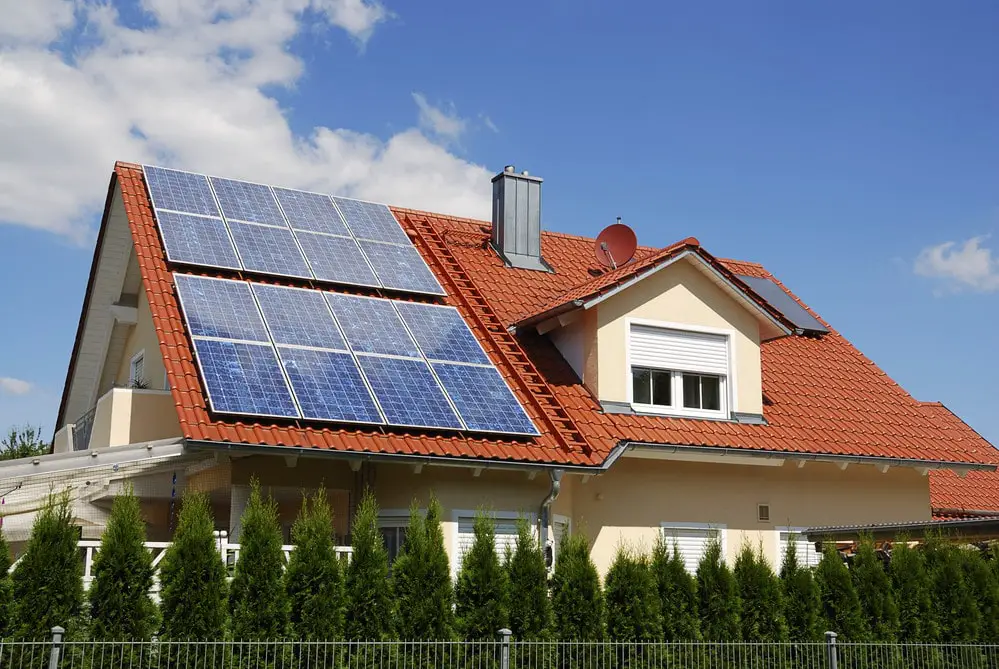
This system uses solar energy to help the compressor in the refrigeration task. Electricity runs the fans and electric control components.
Solar PV Hybrid AC
This system can switch between battery power and solar power when needed. We discussed this already in detail as this is the solar-powered AC unit system, just named differently.
Absorption Chillers
Absorption chillers use solar energy to power the motor and fan in the heating and cooling action that produces cool air via water evaporation and condensation. These ACs can be run off batteries or can be plugged in to use electricity load.
What Are The Disadvantages of Using Solar Energy?
Solar energy is a renewable source of energy that is needed for the future of our planet. It’s sustainable, reduces our utility bill, diversifies its application, and consists of low maintenance costs. However, there are some pitfalls to solar energy.
Cost
The layout cost of buying a solar system is relatively high. It includes the purchase of solar panels, batteries, inverters, wiring, and installation costs.
It’s Weather Dependent
You can collect and store solar energy when the sun is not out, but this drops the efficiency of the system. It’s dependent on sunlight to work effectively to collect solar energy.
Takes Up Space
The solar panels are massive. If you want more electricity, then you’d need more solar panels because you’d like to gather as much sunlight as possible. The PV panels require a lot of space, and most homes cannot accommodate areas of that magnitude for large amounts of solar energy generation.
Pollution
Transportation and installation of PV systems have been linked to greenhouse gas emissions that are the leading cause of pollution in the air. Apart from that, it is associated with some hazardous and toxic material in the manufacturing process. This toxicity indirectly impacts our environment.
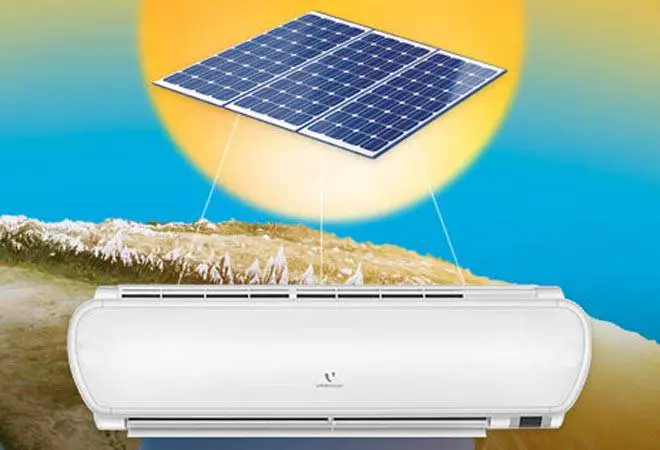
Top Brands in the Solar Powered AC Space
Several companies manufacture solar-powered air conditioners. The top three brands based on their quality and budget include SolAir World, Event Solar and Wind, and Lezeti.
SolAir World
The SolAir World brand has three various sizes of solar-powered ACs that are entirely off-grid systems. They’re an international company that produces solar energy-saving products.
The company has a 48V off-grid solar AC that uses a battery bank, and they supply the whole system, which includes the AC unit, PV panels, batteries, inverters, and charge controller. Their product comes with a one-year labor guarantee and a three-year guarantee on parts.
Event Solar and Wind
The Event Solar and Wind have been on the market for two decades, wholesaling solar and wind products. This product is unique because it doesn’t need other power sources, and it runs on DC power instead of AC (alternating current) power.
There’s a variable speed changeable capacity, and you have control of the airflow of the refrigerant. You can self-install, and it’s low-cost maintenance. There are fixed warranties if the company does the installation for you.
Lezeti
The Lezeti features a hybrid system with a 780W DC power that can run on AC or DC power. It cools a 750 square meter area with high efficiency. This brand can be run on two PV panels, and there’s no need for batteries. It also has an easy-to-use remote and can be self-installed. There are a one-year labor and two-year parts warranty.
Is Solar Powered Air Conditioning Worth It?
It’s challenging to be sure whether a solar-powered AC is worth the effort. Installing a solar-powered AC with your current system will help with utility bill savings; however, a complete install of a solar panel for all other electricity usages will also bring down cooling costs. Let’s break it down a little.
Just say you may spend $1,400 yearly on utilities, and out of that, about $170 may go for air conditioning. If you install a solar-powered AC that costs $3,700 after a federal tax refund, it will take almost twenty-one years to cover the system’s cost.
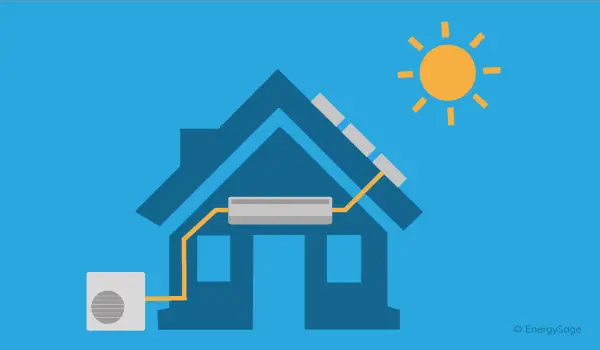
If you decide to install a solar panel system that feeds the whole of the household electricity, it would cost you on average $14,000 for the system after a federal tax refund. It’ll take you ten years to cover the cost.
The period to cover a solar panel system costs is almost half the period for a solar-powered air conditioner.
From breaking this down, you can decide for yourself whether it is worth the effort or not.
Who Should Not Buy a Solar Powered Air Conditioner?
If you’re looking at drastic savings in cost reduction, then a solar-powered air conditioner may not be such a great idea. As we broke down the estimated costs above, it’d make more sense to install a PV system that’ll power your whole household electricity.
The site that needs to be cooled also requires some consideration. The larger the area, the harder your AC will work to cool the air. It means that your energy consumption would be higher. To supply cool air to a larger area, you’d need a lot more PV panels.
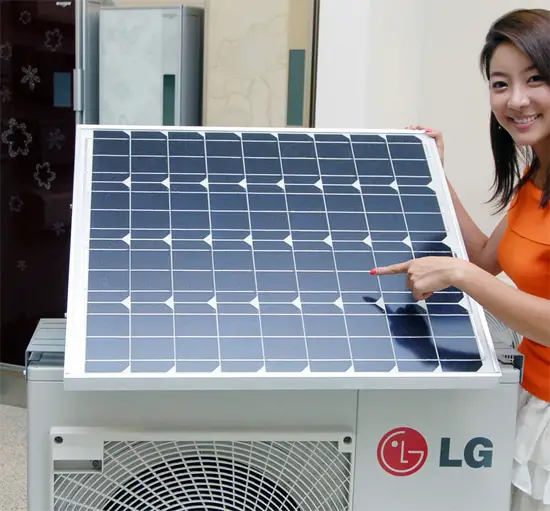
The solar-powered AC may not be for you if you think if you can only afford the minimal panels for a larger home, office area, or industrial workplace.
This factor can also be applied to how much human presence is in the area or if it has a high human activity level, such as using the space for exercise classes. Human activity increases heat, and so does other equipment such as printers and computers.
Again, higher heat levels equate harder the air conditioner works, resulting in higher energy consumption and more PV panels to support the increased solar energy utilization.
Lastly, and the most valid point, is if you’re living in an area that doesn’t have enough sunlight for the day, then a solar-powered AC would serve you minimal purpose. Solar systems depend primarily on the sun. No sun means no solar energy.
Conclusion
Technological advancements are perpetual, and the solar-powered AC is finally here. Considering the environmental issues, it only makes sense that we move towards a more sustainable future using renewable energy.
There are many advantages to having a solar-powered AC. However, there are some disadvantages you should consider before installing a system.
Many top brands have been in the market for about two decades. There’s no doubt that these companies are looking for better ways to advance and improve solar air conditioning technology.
When all is said and done, the solar-powered AC may still not be suited for you or your budget. This is a decision only you can make.
People Also Ask
People want to get into sustainable living for both the environment and to save costs. Solar-powered AC system works off renewable energy from the sun. There are several questions asked by individuals who are interested in solar-powered AC.
There are several factors to consider when installing a solar air conditioner. The manufacturing brand, how many PV panels you’d require to supply power to the HVAC, installation costs efficiently, or whether the AC system needs battery packs and/or inverters. The average price of a 6,000-watt system is between $4,300 to $11,000.
The amount of solar power needed depends on the BTUs and wattage of your air conditioning unit. Solar power is measured in wattages, and each PV panel has a 330W capacity. If your air conditioner operates on 660W, then the solar energy to run it will be 660W.
The capacity of the AC will determine the number of panels you need. For example, in a hybrid 9000 BTU, you’ll need 650-watts. This wattage requires two 330W PV panels to power the AC. If you look at a hybrid with 24,000 BTU, this would need five 330W panels to power it.
